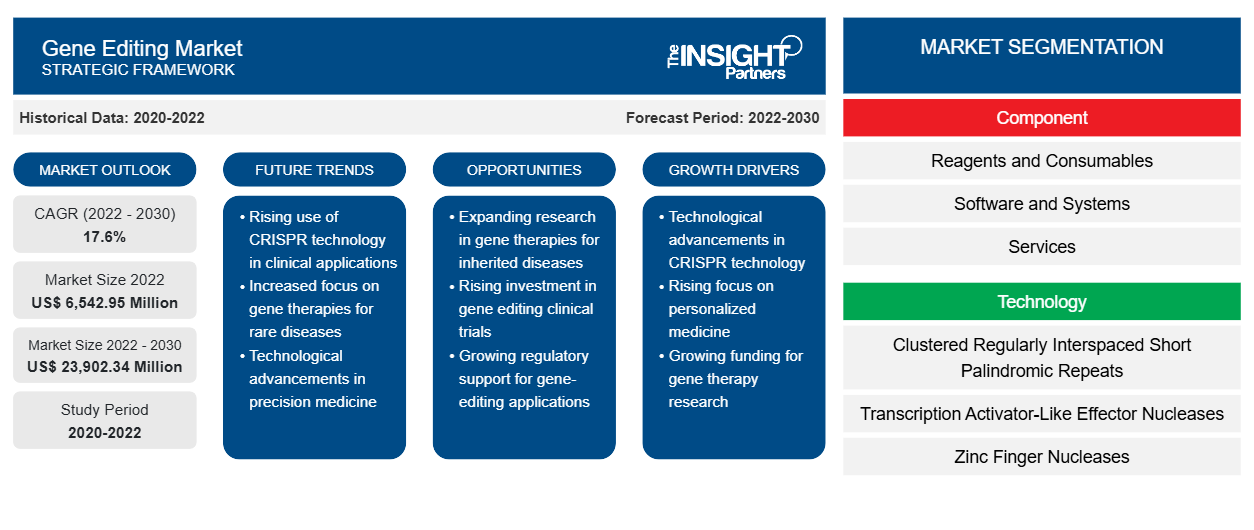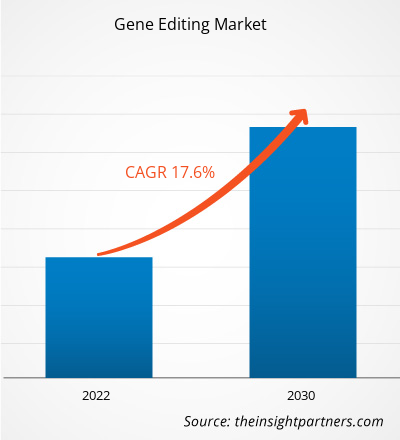[Research Report] The gene editing market size is projected to grow from US$ 6,542.95 million in 2022 to US$ 23,902.34 million by 2030; it is estimated to record a CAGR of 17.6% during 2022–2030.
Market Insights and Analyst View:
Gene editing, also called genome editing, is a technique for modifying an organism's DNA using a variety of methods. Conditions such as cystic fibrosis, sickle cell disease, cancer, and others can be treated and prevented through gene editing. The growth of the gene editing market is anticipated to be fueled by rising government funding, an increase in the number of genomics projects, and growing implementation of genome editing technology.
Growth Drivers:
The increasing prevalence of cancer has created a burden on healthcare systems across the world. According to the World Health Organization (WHO), cancer is one of the biggest causes of death worldwide, with ~10 million deaths in 2020. According to the American Cancer Society, ~1,898,160 new cancer cases and 608,570 cancer deaths occurred in the US in 2021. Nearly 10% to 20% of all cancers are related to gene mutations that are inherited or passed down through the family. Approximately 5–10% of cancers diagnosed in the US are associated with hereditary cancer syndromes. In the US, ~1,958,310 new cancer cases and 609,820 cancer deaths are anticipated to occur in 2023. Additionally, as per the International Agency for Research on Cancer, new cancer incidences were projected to reach 30.2 million by 2040. According to the study titled "Spotlight on Gene Therapy in China," published in July 2020, over 57 million people suffer from genetic diseases in the country, and ~4 million new cancer cases are recorded per year.
The prevalence of genetic diseases is rising across the world and impacting the health of people at a severe level. Most genetic diseases are rare and are developed due to mutations in people's genetic makeup. According to the University of Sheffield research, ~300 million people are living with genetic diseases around the world. In 2022, a report by MJH Life Sciences (US) estimated that 300,000 newborns worldwide are born with sickle cell disease (SCD) every year, accounting for ∼5% of the global population. According to a study on sickle cell disease published in the National Library of Medicine, 400,000 newborns are expected to have sickle cell disease by 2050.
As per the study titled "Sickle Cell Disease," published in August 2023, 1 in 500 African Americans is affected by SCD. In June 2020, as per Novartis AG (Switzerland) report, ∼15,000 individuals were suffering from SCD in the UK, and 270 newborns are diagnosed with the condition every year. In addition, the disease is most prevalent in emerging nations such as India. Among India's tribal communities, ∼18 million people are affected by sickle cell trait (SCT), and 1.4 million people are suffering from SCD.
Many cancer biology investigations are now using clustered regularly interspaced short palindromic repeats (CRISPR) as a standard approach. This technology has also been utilized to enhance the effectiveness and safety profiles of cancer immunotherapy, such as CAR-T cell therapies.
The CRISPR/Cas9 system has been demonstrated to be efficient in treating metastatic tumors, which is a major step toward discovering a cancer cure. The CRISPR-LNP system contains a messenger RNA that encodes for the Cas9 CRISPR enzyme, which is a molecular scissor that cuts the DNA of cells.
Cutting-edge gene editing techniques hold immense promise for tackling dreadful diseases such as SCD. Advancements in technologies such as CRISPR-Cas9 have paved the way for precise and efficient gene editing, allowing the possibility of correcting genetic mutations and modifying disease-causing genes. Thus, the increasing prevalence of cancer and other genetic disorders is expected to boost the gene editing market growth during the forecast period.
Customize This Report To Suit Your Requirement
You will get customization on any report - free of charge - including parts of this report, or country-level analysis, Excel Data pack, as well as avail great offers and discounts for start-ups & universities
Gene Editing Market: Strategic Insights

-
Get Top Key Market Trends of this report.This FREE sample will include data analysis, ranging from market trends to estimates and forecasts.
Report Segmentation and Scope:
The gene editing market is segmented on the basis of component, technology, application, end user, and geography. Based on component, the gene editing market is categorized into reagents and consumables, software and systems, and services. Based on technology, the gene editing market is classified into clustered regularly interspaced short palindromic repeats, transcription activator-like effector nucleases, zinc finger nucleases, and other technologies. The gene editing market, by application, is bifurcated into genetic engineering and clinical applications. Based on end users, the gene editing market is segmented into pharmaceutical companies and biotechnology companies, academics and government research institutes, and clinical research organizations. The gene editing market, based on geography, is segmented into North America (the US, Canada, and Mexico), Europe (France, Germany, the UK, Spain, Italy, and the Rest of Europe), Asia Pacific (China, India, Japan, Australia, South Korea, and the Rest of Asia Pacific, the Middle East & Africa (Saudi Arabia, the UAE, South Africa, and the Rest of Middle East & Africa), and South & Central America (Brazil, Argentina, and the Rest of South & Central America).
Segmental Analysis:
The gene editing market, by component, is categorized into reagents and consumables, software and systems, and services. The services segment held the largest share of the market in 2022. However, the reagents and consumables segment is expected to register the highest CAGR in the market during 2022–2030.
Based on technology, the gene editing market is segmented into clustered regularly interspaced short palindromic repeats, transcription activator-like effector nucleases, zinc finger nucleases, and other technologies. In 2022, the clustered regularly interspaced short palindromic repeats segment held the largest share of the market, and it is anticipated to record the fastest CAGR during 2022–2030.
Based on application, the gene editing market is bifurcated into genetic engineering and clinical applications. In 2022, the clinical applications segment held a larger share of the market and is anticipated to grow at a higher CAGR during 2022–2030.
Based on end user, the gene editing market is segmented into pharmaceutical companies and biotechnology companies, academics and government research institutes, and clinical research organizations. The pharmaceutical companies and biotechnology companies segment held the largest share of the market in 2022 and is expected to register the highest CAGR during 2022–2030.
Regional Analysis:
The gene editing market is primarily divided into North America, Europe, Asia Pacific, South & Central America, and the Middle East & Africa. In 2022, North America captured a significant share of the market. In 2022, the US held the largest share of the market in the region. The market growth in North America is attributed to the rising investments in the R&D of gene editing technologies, presence of biotechnology and pharmaceutical companies working on the development of genome editing technologies, and increasing product approvals. Moreover, the growing prevalence of genetic disorders and the adoption of advanced gene therapy for the treatment of chronic diseases is estimated to fuel the market growth in the country. For instance, as per the estimates of Cystic Fibrosis Foundation published in July 2022, 40,000 people are living with cystic fibrosis in the US. Furthermore, according to the Centers for Disease Control and Prevention (CDC), ~1,603,844 new cancer cases were diagnosed in 2020, with 602,347 cancer deaths in the US. For every 100,000 individuals, 403 new cancer cases were reported.
In October 2020, Merck signed a licensing agreement with Takara Bio USA, Inc. Merck authorized Takara to use its CRISPR technology to develop vectors and other innovative products to support research using CRISPR and engineering services, particularly stem cells. Thus, such factors support the growth of the market in the region during the forecast period.
Gene Editing Market Regional InsightsThe regional trends and factors influencing the Gene Editing Market throughout the forecast period have been thoroughly explained by the analysts at The Insight Partners. This section also discusses Gene Editing Market segments and geography across North America, Europe, Asia Pacific, Middle East and Africa, and South and Central America.
Gene Editing Market Report Scope
| Report Attribute | Details |
|---|---|
| Market size in 2022 | US$ 6,542.95 Million |
| Market Size by 2030 | US$ 23,902.34 Million |
| Global CAGR (2022 - 2030) | 17.6% |
| Historical Data | 2020-2022 |
| Forecast period | 2022-2030 |
| Segments Covered |
By Component
|
| Regions and Countries Covered |
North America
|
| Market leaders and key company profiles |
|
Gene Editing Market Players Density: Understanding Its Impact on Business Dynamics
The Gene Editing Market is growing rapidly, driven by increasing end-user demand due to factors such as evolving consumer preferences, technological advancements, and greater awareness of the product's benefits. As demand rises, businesses are expanding their offerings, innovating to meet consumer needs, and capitalizing on emerging trends, which further fuels market growth.

- Get the Gene Editing Market top key players overview
Industry Developments and Future Opportunities:
Various initiatives taken by key players operating in the global gene editing market are listed below:
- In April 2022, Thermo Fisher Scientific introduced the GMP-manufactured Gibco CTS TrueCut Cas9 Protein to help researchers meet stringent quality requirements while using genome editing tools. It is a promising option for CAR T-cell therapy studies using CRISPR-Cas9 genome editing as it consistently provides higher than 90% efficacy in human primary T-cells and high editing effectiveness in all examined cell lines.
Competitive Landscape and Key Companies:
Thermo Fisher Scientific; GenScript; Lonza; Merck KGaA; CRISPR Therapeutics; PerkinElmer Inc.; Agilent Technologies, Inc.; Precision Biosciences; Sangamo Therapeutics, Inc.; New England Biolabs; and Novartis are among the prominent players in the gene editing market. These companies focus on introducing new high-tech products, advancements in existing products, and geographic expansions to meet the growing consumer demand worldwide.
Frequently Asked Questions
Who are the major players in the gene editing market?
What are the driving and restraining factors for the gene editing market?
What is gene editing?
What was the estimated gene editing market size in 2022?
What are the growth estimates for the gene editing market till 2030?
Which segment is dominating the gene editing market?
- Historical Analysis (2 Years), Base Year, Forecast (7 Years) with CAGR
- PEST and SWOT Analysis
- Market Size Value / Volume - Global, Regional, Country
- Industry and Competitive Landscape
- Excel Dataset
Recent Reports
Testimonials
Reason to Buy
- Informed Decision-Making
- Understanding Market Dynamics
- Competitive Analysis
- Identifying Emerging Markets
- Customer Insights
- Market Forecasts
- Risk Mitigation
- Boosting Operational Efficiency
- Strategic Planning
- Investment Justification
- Tracking Industry Innovations
- Aligning with Regulatory Trends





















 Get Free Sample For
Get Free Sample For